List of Sites of Special Scientific Interest in Hertfordshire

Hertfordshire is a county in eastern England. It is bordered by Bedfordshire to the north, Cambridgeshire to the north-east, Essex to the east, Buckinghamshire to the west and Greater London to the south. The county town is Hertford. As of June 2014, the county has a population of 1,154,800[1] in an area of 634 square miles (1,640 km2).[2]
As of January 2016, there are 43 sites designated within this Area of Search, 36 of which have been designated for their biological interest and 7 for their geological interest.[3] In England the body responsible for designating SSSIs is Natural England, which chooses a site "because of its flora, fauna, or geological or physiographical features".[4]
The data in the table is taken from Natural England's website in the form of citation sheets for each SSSI.
Key
Interest
- B = a site of biological interest
- G = a site of geological interest
Other classifications
- CAONB = Chilterns Area of Outstanding Natural Beauty
- GCR = Geological Conservation Review
- EWT = Essex Wildlife Trust
- HMWT = Herts and Middlesex Wildlife Trust
- LNR = Local nature reserve
- NCR = A Nature Conservation Review
- NNR = National nature reserve
- NT = National Trust
- Ramsar = Ramsar site
- RHPG = Register of Historic Parks and Gardens of Special Historic Interest in England
- RSPB = Royal Society for the Protection of Birds
- SM = Scheduled Monument
- SPA = Special Protection Area
- WT = Woodland Trust
Sites
| Site name | Photograph | B | G | Area[lower-alpha 1] | Public access |
Location[lower-alpha 1] | Other classifications |
Map[lower-alpha 1] | Citation[lower-alpha 1] | Description |
|---|---|---|---|---|---|---|---|---|---|---|
| Aldbury Nowers | 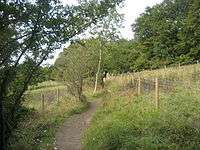 |
19.8 hectares (49 acres) | YES | Tring 51°48′43″N 0°37′19″W / 51.8120°N 0.6219°W SP951135 |
HMWT[5] | Map | Citation | The site hosts the flowers of chalk grassland and has butterfly habitats with several different species of butterfly including the Duke of Burgundy, hairstreaks and the Essex skipper. There are also large areas of woodland and calcareous grassland.[6][7] | ||
| Alpine Meadow | 0.8 hectares (2.0 acres) | YES | Berkhamsted 51°46′57″N 0°34′04″W / 51.7826°N 0.5677°W SP989103 |
HMWT[8] | Map | Citation | This steeply sloping small meadow is a rare example of unimproved chalk grassland. Grass species include upright brome, false brome and sheep's fescue, and there are many orchids, especially common twayblade and common spotted orchid.[9] | |||
| Amwell Quarry | 37.1 hectares (92 acres) | YES | Amwell 51°47′52″N 0°00′16″W / 51.7978°N 0.0045°W TL377129 |
HMWT,[10] SPA, SPA[11] Ramsar[12] | Map | Citation | This is an internationally important site for wintering wildfowl, and is Britain's most important site for dragonflies. Plants include marsh dock and hairlike pondweed, both nationally rare. Amwell has a quarter of all British species of molluscs.[13][14] | |||
| Ashridge Commons & Woods | 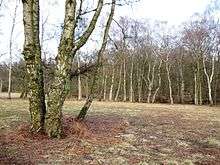 |
627.3 hectares (1,550 acres) | YES | Little Gaddesden 51°48′42″N 0°35′14″W / 51.8116°N 0.5871°W SP975135 |
CAONB,[15] NT[15] | Map | Citation | Ths site is mainly semi-natural vegetation, with has extensive areas of woodland, grass and scrub. There are many species of breeding birds, including some which are rare nationally, such as firecrests. Other species which are rare in Hertfordshire are redstart, nightingale and wood warbler.[16] | ||
| Ashwell Springs |  |
0.3 hectares (0.74 acres) | YES | Ashwell 52°02′32″N 0°08′59″W / 52.0421°N 0.1497°W TL270398 |
Map | Citation | The site consists of a series of freshwater springs, which provide a habitat for cold water, invertebrate animals, some of which are rare. The site is particularly important for flatworms, including Crenobia alpina and the Polycelis felina.[17] | |||
| Benington High Wood | 20.7 hectares (51 acres) | YES | Benington 51°53′43″N 0°08′02″W / 51.8952°N 0.1339°W TL285235 |
Map | Citation | The site is ancient woodland, described by Natural England as "one of the best remaining examples in the county of the pedunculate oak-hornbeam of the ash-maple variety". Shrub species include field maple and hazel, with a higher ground flora diversity in clearings and rides.[18] | ||||
| Blagrove Common | 5.0 hectares (12 acres) | YES | Sandon 51°59′12″N 0°04′13″W / 51.9868°N 0.0704°W TL326338 |
HMWT[19] | Map | Citation | The site is one of the few areas of unimproved marshy grassland in east Hertfordshire. It is crossed by a stream and has a rich diversity of vegetation, including a variety of orchids.[20] Kestrels often hunt mice and voles, which are common on the site.[21] | |||
| Bricket Wood Common | 75.5 hectares (187 acres) | YES | Bricket Wood 51°41′47″N 0°21′59″W / 51.6964°N 0.3664°W TL130010 |
Map | Citation | The common is a remnant of a lowland heath, with much it on the heavy soils of boulder clay which have poor drainage and wet habitats. There are also areas of ancient woodland and dry heath. In drier heath areas there are heather, purple moor-grass and heath milkwort.[22] | ||||
| Castle Lime Works Quarry | 1.4 hectares (3.5 acres) | NO | South Mimms 51°42′31″N 0°13′22″W / 51.7087°N 0.2227°W TL229026 |
GCR[23] | Map | Citation | Natural England states: "This reveals extensive piping in the top of the chalk resulting from solution at the Chalk - Tertiary sediment interface. Believed to have formed during the Tertiary and Pleistocene, it is the finest exposure of clay-filled pipes in the Chalk Karst of England."[24] | |||
| Croxley Common Moor | 39.6 hectares (98 acres) | YES | Croxley Green 51°38′33″N 0°26′11″W / 51.6425°N 0.4363°W TQ083949 |
LNR[25] | Map | Citation | The site is mainly grass heathland with some ancient woodland and hazel coppice. Over 250 species of plants have been recorded, including sheep sorrel, common bent and sheep's fescue. There are many ant hills made by yellow meadow ants.[26][27] | |||
| Downfield Pit, Westmill | 0.3 hectares (0.74 acres) | YES | Ware 51°49′51″N 0°02′37″W / 51.8308°N 0.0437°W TL349165 |
Map | Citation | The site provides an example of the complex sequence of Pleistocene gravels and clays laid down by the River Thames when it flowed through the Vale of St Albans before the river was diverted south by the Anglian ice age around 450,000 years ago.[28] | ||||
| Frogmore Meadows | 4.6 hectares (11 acres) | YES | Chenies 51°40′47″N 0°31′29″W / 51.6796°N 0.5247°W TQ021989 |
CAONB,[29] HMWT,[30] | Map | Citation | The site has marshy areas and fens next to the river, damp grassland and drier, more acidic areas. The river bank has water voles, and damp areas are dominated by meadow foxtail and Yorkshire fog, with some marsh marigold and marsh bedstraw.[31][32] | |||
| Great Hormead Park | 15.0 hectares (37 acres) | YES | Great Hormead 51°56′36″N 0°03′42″E / 51.9432°N 0.0616°E TL418292 |
Map | Citation | The site is coppiced ancient woodland on boulder clay. It has diverse tree species, including wych elm and hornbeam, resulting in a rich ground flora. Dog's mercury is dominant over most of the woodland floor, with plants such as angelica sylvestris and tufted hair grass in wetter areas.[33] | ||||
| Hertford Heath | 29.1 hectares (72 acres) | YES | Hertford Heath 51°46′53″N 0°02′14″W / 51.7813°N 0.0372°W TL355110 & TL350106 |
HMWT[34] | Map | Citation | The heath is dominated by heather, and there are grass snakes and slow worms. Sphagnum mosses and creeping willow are found in wetter areas. Ponds support the rare water violet and a rich invertebrate fauna such as great crested and smooth newts, the water spider and eight species of dragonfly.[35][36] | |||
| Hillcollins Pit | 0.2 hectares (0.49 acres) | YES | Furneux Pelham 51°55′16″N 0°05′43″E / 51.9211°N 0.0954°E TL442268 |
GCR[37] | Map | Citation | This disused gravel pit is the type site for the Westland Green Gravels, which were laid down by the ancestral River Thames 1.6 to 1.8 million years ago, and which show the river's ancient course.[38] | |||
| Hunsdon Mead |  |
34.2 hectares (85 acres) | YES | Harlow 51°46′47″N 0°03′15″E / 51.7797°N 0.0541°E TL418110 |
HMWT[39] | Map | Citation | This is unimproved grassland which is subject to winter flooding. Notable grass species include meadow brome and the quaking grass briza media, and there are other unusual flora such as pepper saxifrage and green-winged orchid.[40] | ||
| Knebworth Woods | 128.8 hectares (318 acres) | YES | Stevenage 51°53′09″N 0°13′02″W / 51.8857°N 0.2172°W TL228223 |
Map | Citation | The wood is ancient in origin and ecologically diverse. The dominant trees are oak and hornbeam. Ponds have unusual plant species, and the site is rich in fungi and bryophytes. Breeding birds include nightingales.[41] | ||||
| Little Heath Pit | 1.2 hectares (3.0 acres) | YES | Potten End 51°45′48″N 0°31′40″W / 51.7633°N 0.5278°W TL017082 |
GCR,[42] NT[43] | Map | Citation | The lowest layer is gravel dating to the beginning of the Pleistocene 2.6 million years ago. A higher layer of gravel was laid down some 20,000 years ago, when the last ice age was at its maximum, and the site was cold tundra like western Siberia today.[44] | |||
| Moor Hall Meadows | 24.0 hectares (59 acres) | YES | Ardeley 51°55′16″N 0°04′03″W / 51.9211°N 0.0674°W TL330265 |
Map | Citation | The site has a variety of types of meadows, with marshy grassland being the most extensive. Its rich flora makes it one of the most important grassland sites in the county. There is also a small ancient woodland which has a variety of breeding birds.[45] | ||||
| Moor Mill Quarry, West |  |
0.2 hectares (0.49 acres) | NO | How Wood 51°42′43″N 0°21′02″W / 51.7119°N 0.3506°W TL141027 |
GCR[46] | Map | Citation | The pit displays the advance of ice during the Anglian glaciation around 450,000 years ago, which diverted the Thames south to its present course. The site is regarded by Natural England as of fundamental importance as the only one which demonstrates the diversion of the Thames from its pre-Anglian course.[47] | ||
| Northaw Great Wood |  |
224.3 hectares (554 acres) | YES | Cuffley 51°43′22″N 0°08′54″W / 51.7228°N 0.1483°W TL280043 |
LNR[48] | Map | Citation | The site has one of the county's most exensive areas of ancient hornbeam woodland, with other trees including oak and silver birch. Glades, streams and springs add to the biodiversity.[49] | ||
| Oddy Hill and Tring Park | 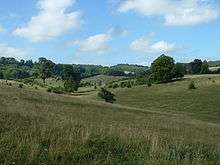 |
36.0 hectares (89 acres) | YES | Tring 51°47′20″N 0°38′50″W / 51.7890°N 0.6473°W SP934109 51°47′01″N 0°39′22″W / 51.7837°N 0.6561°W SP928103 |
RHPG.[50] | Map | Citation | This is one of the most extensive areas of unimproved chalk downland in Hertfordshire. The site has diverse grass and flowering plant species Orchids include common spotted-orchid, common twayblade, greater butterfly-orchid and southern marsh-orchid.[51] | ||
| Oughtonhead Lane | 1.0 hectare (2.5 acres) | YES | Hitchin 51°57′19″N 0°17′45″W / 51.9552°N 0.2959°W TL172299 |
GCR[52] | Map | Citation | The site probably dates to the Hoxnian interglacial 420,000 to 300,000 years ago. It was then a marsh fed by springs, and it has a tufa which contains fossil land snails and mammal bones which show the climate and local environmental conditions.[53] | |||
| Patmore Heath | 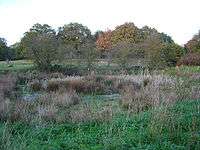 |
8.5 hectares (21 acres) | YES | Albury 51°54′43″N 0°05′47″E / 51.9120°N 0.0965°E TL443258 |
HMWT[54] | Map | Citation | The site is home to a large amount of dry grass, as well as marshy-areas. Much of the turf is dominated by Deschampsia, as well as occurrences of Anthoxanthum odoratum. Uncommon plants are heath rush and heath grass. There are a wide variety of dragonfly, including the emperor dragonfly.[55] | ||
| Plashes Wood | 73.2 hectares (181 acres) | YES | Standon 51°52′01″N 0°00′21″E / 51.8669°N 0.0058°E TL382206 |
Map | Citation | The site is mainly oak and hornbeam woodland near the northern limit of its natural distribution. It has varied ground flora on soils from damp heavy clay to light gravels. There are also ponds and extensive clearings dominated by bracken, and other flora including hoary cinquefoil.[56] | ||||
| Redwell Wood | 52.6 hectares (130 acres) | YES | South Mimms 51°42′29″N 0°14′45″W / 51.7081°N 0.2459°W TL213025 |
Map | Citation | The site has ancient and secondary woodland, heath and scrub. The woodland canopy is dominated by pedunculate oak. Ground flora include bluebells and enchanter’s-nightshade, while heathland species include heather and the rare creeping willow.[57] | ||||
| Roughdown Common | 3.7 hectares (9.1 acres) | YES | Hemel Hempstead 51°44′25″N 0°29′06″W / 51.7402°N 0.4850°W TL047057 |
CAONB[58] | Map | Citation | This is one of the few examples of unimproved calcareous grassland in Hertfordshire. The dominant grasses are meadow fescue and meadow oat-grass, and there are colonies of orchids. It is the only site in the county where common juniper regenerates naturally.[59][60] | |||
| Rye Meads |  |
60.3 hectares (149 acres) | YES | Rye House 51°46′34″N 0°00′22″E / 51.7760°N 0.0061°E TL385105 |
Ramsar,[61] SPA[11] RSPB,[61] HMWT[62] | Map | Citation | Part of this site is an ancient flood meadow which has a variety of habitats including reedbed, marshy grassland and fen. It is grazed by ponies and water buffalo.[63] There are also ponds which have kingfisher, snipe, green sandpiper, shoveler, gadwall and tufted duck.[64] | ||
| Sarratt Bottom | 3.5 hectares (8.6 acres) | NO | Sarratt 51°40′46″N 0°30′37″W / 51.6794°N 0.5102°W TQ031989 |
Map | Citation | The site is a meadow beside the River Chess. It is an example of damp grassland which has been traditionally managed for grazing. There are also areas of swamp and marsh. The main plants in grassland areas include sweet vernal grass and meadow foxtail, and marsh horsetail and common spike-rush are common in damper areas.[65] | ||||
| Sawbridgeworth Marsh | 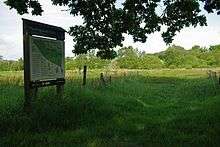 |
6.2 hectares (15 acres) | YES | Sawbridgeworth 51°49′15″N 0°09′48″E / 51.8209°N 0.1634°E TL492158 |
EWT[66] | Map | Citation | The site is a river valley marsh close to the River Stort, which has a varied wetland flora. Grazing and cutting of the marsh in rotation maintain biological diversity. The site also has an important wetland fauna and many moth species.[67] | ||
| Sherrardspark Wood |  |
74.4 hectares (184 acres) | YES | Welwyn Garden City 51°48′37″N 0°13′02″W / 51.8102°N 0.2172°W TL230139 |
LNR[68] | Map | Citation | The site is an ancient semi-natural sessile oak and hornbeam wood on acid soils. There are also swallowholes fed by streams, and a woodland ride provides a habitat for invertebrates.[69] | ||
| Tewinbury | 7.3 hectares (18 acres) | NO | Tewin 51°48′34″N 0°10′04″W / 51.8095°N 0.1679°W TL264139 |
HMWT[70] | Map | Citation | The site borders the River Mimram. It has alluvial meadows and marshes which are rare in lowland Britain. There are areas of swamp and tall fens, with plants including butterbur and angelica. Otters have been observed on the riverbank, in possibly the only site in the county.[71][72] | |||
| Therfield Heath |  |
146.5 hectares (362 acres) | YES | Therfield 52°02′32″N 0°03′18″W / 52.0423°N 0.0549°W TL335400 |
LNR,[73] SM[74][75] | Map | Citation | This site is described by Natural England as describing some to the richest chalkland in England. It is unimproved pasture which has a wide variety of plants including the rare pasque flower. There is a diverse insect fauna.[76] | ||
| Thorley Flood Pound | 17.3 hectares (43 acres) | YES | Thorley 51°50′36″N 0°09′41″E / 51.8434°N 0.1615°E TL490183 |
HMWT[77] | Map | Citation | Habitats include tall wash grassland, which is now rare, marsh and waterlogged grassland. It has a wide variety of plant species, including reed sweet-grass and meadowsweet. There are flowers such as fen bedstraw and early marsh orchid. Breeding birds include snipe and water rails.[78] | |||
| Tring Reservoirs |  |
100.0 hectares (247 acres) | YES | Tring 51°48′49″N 0°40′06″W / 51.8135°N 0.6683°W SP919136 SP905131 |
HMWT[79] | Map | Citation | These four reservoirs are on the sites of ancient marshes, and their diverse fauna and flora include some dating back to their marshland origins. The site is important for breeding and wintering birds, including nationally important numbers of shovelers. The site is also significant for invertebrates.[80] | ||
| Tring Woodlands |  |
24.1 hectares (60 acres) | YES | Tring 51°46′52″N 0°40′20″W / 51.7812°N 0.6721°W SP917100 |
CAONB[81] | Map | Citation | The wood has a rich flora, showing that it is well established. It is one of the best examples of semi-natural beech woodland in Hertfordshire. Plants include woodruff, wood anemone and dog's mercury, and there is a variety of woodland birds.[82] | ||
| Turnford and Cheshunt Pits | 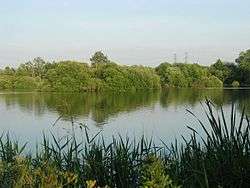 |
174.4 hectares (431 acres) | YES | Cheshunt 51°42′32″N 0°01′07″W / 51.7090°N 0.0186°W TL370030 |
SPA[11] | Map | Citation | This site includes ten former gravel pits, which are of national importance for wintering gadwalls and shovelers. It is also valuable for invertebrates, especially grasshoppers and bush-crickets.[83] | ||
| Wain Wood |  |
19.0 hectares (47 acres) | YES | Preston 51°54′56″N 0°17′09″W / 51.9155°N 0.2858°W TL180255 |
Map | Citation | The wood lies on a north-east facing slope of decalcified boulder clay. The woodland area is also home to Pedunculate Oak and Quercus petraea, with much of the south of the area consisting of acidic grassland. There are many butterfly species, including Thecla quercus.[84] | |||
| Water End Swallow Holes |  |
11.1 hectares (27 acres) | YES | Welham Green 51°43′26″N 0°13′14″W / 51.7239°N 0.2206°W TL230043 |
Map | Citation | The site covers more than fifteen sinkholes, the only ones in chalk which are a permanent feature of the landscape. Next to the holes is a swamp area of willow carr which is biologically important, and in deep water there is Reed Sweet-grass. The site also has areas of woodland and grassland.[85] | |||
| Westwood Quarry | 0.1 hectares (0.25 acres) | NO | Watford 51°40′56″N 0°27′08″W / 51.6823°N 0.4523°W TQ071993 |
GCR[86] | Map | Citation | This site throws light on the early history of the River Thames, when it flowed through the Vale of St Albans, before it was diverted south to its present course during the Anglian Ice Age around 450,000 years ago.[87] | |||
| Whippendell Wood | 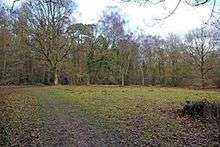 |
66.7 hectares (165 acres) | YES | Watford 51°40′07″N 0°26′44″W / 51.6687°N 0.4455°W TQ076978 |
Map | Citation | This is ancient woodland, and the main trees are oak, ash, hazel and hornbeam. Ground flora include Yorkshire Fog, bluebells and honeysuckle. There are diverse species of fungi, invertebrates and birds.[88] | |||
| Wormley-Hoddesdonpark Wood North | 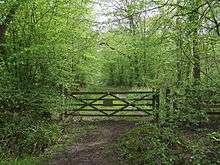 |
143.9 hectares (356 acres) | YES | Hoddesdon 51°45′32″N 0°02′33″W / 51.7589°N 0.0425°W TL352085 TL325075 |
NNR,[89] WT,[89] NCR,[90] HMWT,[91] SAC[92] | Map | Citation | The site is oak and hornbeam on acid gravel. The ground flora is diverse, including dog’s mercury and yellow archangel. Small ponds and streams are important for bryophytes, and invertebrates include the green tiger beetle.[90] | ||
| Wormley-Hoddesdonpark Wood South |  |
196.2 hectares (485 acres) | YES | Cheshunt 51°44′39″N 0°04′25″W / 51.7441°N 0.0735°W TL331068 |
NNR,[93] NCR,[94] SAC[92] | Map | Citation | The site is oak and hornbeam woodland mainly on London clay. Plants in the variable ground flora include brambles, wood anemones and bluebells. Other habitats include marshland and acidic grassland.[94] |
| Wikimedia Commons has media related to Sites of Special Scientific Interest in Hertfordshire. |
See also
Notes
References
- ↑ "Resident Population". Hertfordshire Local Information System. Retrieved 29 July 2015.
- ↑ "Area Measurements". Hertfordshire Local Information System. Retrieved 10 February 2015.
- ↑ "Designated Sites View - Hertfordshire". Natural England. Retrieved 12 January 2016.
- ↑ "Guidelines for selection of biological SSSIs". Joint Nature Conservation Committee. Retrieved 12 January 2016.
- ↑ "Aldbury Nowers". Herts and Middlesex Wildlife Trust. Retrieved 11 January 2016.
- ↑ "Aldbury Nowers" (PDF). Natural England. Retrieved 21 February 2006.
- ↑ "Aldbury Nowers". Herts and Middlesex Wildlife Trust. Retrieved 2011-01-07.
- ↑ "Alpine Meadow". Hertfordshire and Middlesex Wildlife Trust. Retrieved 21 December 2014.
- ↑ "Alpine Meadow citation" (PDF). Sites of Special Scientific Interest. Natural England. Retrieved 21 December 2014.
- ↑ "Amwell". Hertfordshire and Middlesex Wildlife Trust. Retrieved 19 December 2014.
- 1 2 3 "Lee Valley". Joint Nature Conservation Committee. Retrieved 16 January 2016.
- ↑ "Lee Valley". Ramsar Sites Information Service. Retrieved 19 December 2014.
- ↑ "Amwell". Hertfordshire and Middlesex Wildlife Trust. Retrieved 19 December 2014.
- ↑ "Amwell Quarry citation" (PDF). Sites of Special Scientific Interest. Natural England. Retrieved 19 December 2014.
- 1 2 "Ashridge Commons and Woods citation" (PDF). Sites of Special Scientific Interest. Natural England. Retrieved 4 January 2016.
- ↑ "Ashridge Commons & Woods citation" (PDF). Sites of Special Scientific Interest. Natural England. Retrieved 19 December 2014.
- ↑ "Ashwell Springs citation" (PDF). Sites of Special Scientific Interest. Natural England. Retrieved 12 January 2015.
- ↑ "Benington High Wood citation" (PDF). Sites of Special Scientific Interest. Natural England. Retrieved 3 January 2015.
- ↑ "Blagrove Common". Hertfordshire and Middlesex Wildlife Trust. Retrieved 12 January 2015.
- ↑ "Blagrove Common citation" (PDF). Sites of Special Scientific Interest. Natural England. Retrieved 12 January 2015.
- ↑ "Blagrove Common". Hertfordshire and Middlesex Wildlife Trust. Retrieved 12 January 2015.
- ↑ "Bricket Wood Common citation" (PDF). Sites of Special Scientific Interest. Natural England. Retrieved 7 December 2014.
- ↑ "Castle Lime Works Quarry (Karst)". Joint Nature Conservation Committee. Retrieved 11 January 2016.
- ↑ "Castle Lime Works Quarry citation" (PDF). Sites of Special Scientific Interest. Natural England. Retrieved 15 January 2015.
- ↑ "Croxley Common Moor". Local Nature Reserves. Natural England. 13 March 2013. Retrieved 10 December 2014.
- ↑ "Croxley Common Moor citation" (PDF). Sites of Special Scientific Interest. Natural England. Retrieved 10 December 2014.
- ↑ "Croxley Common Moor". Local Nature Reserves. Natural England. 13 March 2013. Retrieved 10 December 2014.
- ↑ "A Geological Conservation Strategy for Hertfordshire" (PDF). Hertfordshire RIGS Group. 2003. p. 43. Retrieved 4 February 2015.
- ↑ "Frogmore Meadows citation" (PDF). Sites of Special Scientific Interest. Natural England. Retrieved 11 December 2014.
- ↑ "Frogmore Meadow". Herts and Middlesex Wildlife Trust. Retrieved 11 December 2014.
- ↑ "Frogmore Meadows citation" (PDF). Sites of Special Scientific Interest. Natural England. Retrieved 11 December 2014.
- ↑ "Frogmore Meadow". Herts and Middlesex Wildlife Trust. Retrieved 11 December 2014.
- ↑ "Great Hormead Park citation" (PDF). Sites of Special Scientific Interest. Natural England. Retrieved 19 February 2015.
- ↑ "Hertford Heath". Herts and Middlesex Wildlife Trust. Retrieved 15 February 2015.
- ↑ "Hertford Heath citation" (PDF). Sites of Special Scientific Interest. Natural England. Retrieved 15 February 2015.
- ↑ "Hertford Heath". Herts and Middlesex Wildlife Trust. Retrieved 15 February 2015.
- ↑ "Furneux Pelham Gravel Pit (Hillcollins Pit) (Quaternary of the Thames)". Joint Nature Conservation Committee. Retrieved 18 February 2015.
- ↑ "Hillcollins Pit citation" (PDF). Sites of Special Scientific Interest. Natural England. Retrieved 18 February 2015.
- ↑ "Hunsdon and Eastwick Meads". Herts & Middlesex Wildlife Trust. Retrieved 11 January 2016.
- ↑ "Hunsdon Mead citation" (PDF). Sites of Special Scientific Interest. Natural England. Retrieved 22 December 2014.
- ↑ "Knebworth Woods citation" (PDF). Sites of Special Scientific Interest. Natural England. Retrieved 3 January 2015.
- ↑ "Little Heath Pit (Quaternary of the Thames)". Joint Nature Conservation Committee. Retrieved 11 January 2016.
- ↑ "Little Heath Pit citation" (PDF). Sites of Special Scientific Interest. Natural England. Retrieved 25 February 2015.
- ↑ Information board on the site
- ↑ "Moor Hall Meadows citation" (PDF). Sites of Special Scientific Interest. Natural England. Retrieved 3 January 2015.
- ↑ "Moor Mill Quarry (Quaternary of the Thames)". Joint Nature Conservation Committee. Retrieved 11 January 2016.
- ↑ "Moor Mill Quarry, West citation" (PDF). Sites of Special Scientific Interest. Natural England. Retrieved 7 December 2014.
- ↑ "Northaw Great Wood Country Park". Local Nature Reserves. Natural England. 14 March 2013. Retrieved 22 March 2015.
- ↑ "Northaw Great Wood citation" (PDF). Sites of Special Scientific Interest. Natural England. Retrieved 23 December 2014.
- ↑ "Tring Park". English Heritage. Retrieved 23 December 2014.
- ↑ "Oddy Hill and Tring Park citation" (PDF). Sites of Special Scientific Interest. Natural England. Retrieved 2 June 2016.
- ↑ "Oughtonhead Lane, Hitchin (Quaternary of East Anglia)". Joint Nature Conservation Committee. Retrieved 11 January 2016.
- ↑ "A Geological Conservation Strategy for Hertfordshire" (PDF). Hertfordshire RIGS Group. 2003.
- ↑ "Patmore Heath". Herts and Middlesex Wildlife Trust. Retrieved 11 December 2014.
- ↑ "Patmore Heath citation" (PDF). Sites of Special Scientific Interest. Natural England. Retrieved 11 December 2014.
- ↑ "Plashes Wood citation" (PDF). Sites of Special Scientific Interest. Natural England. Retrieved 11 March 2015.
- ↑ "Redwell Wood citation" (PDF). Sites of Special Scientific Interest. Natural England. Retrieved 16 January 2015.
- ↑ "Roughdown Common". Chilterns Conservation Board. Retrieved 21 December 2014.
- ↑ "Roughdown Common citation" (PDF). Sites of Special Scientific Interest. Natural England. Retrieved 21 December 2014.
- ↑ "Roughdown Common". Chilterns Conservation Board. Retrieved 21 December 2014.
- 1 2 "Rye Meads (SSSI SPA RAMSAR)". Royal Society for the Protection of Birds, South East Hertfordshire Local Group. Retrieved 28 September 2015.
- ↑ "Rye Meads". Herts and Middlesex Wildlife Trust. Retrieved 11 December 2014.
- ↑ "Rye Meads". Herts and Middlesex Wildlife Trust. Retrieved 11 December 2014.
- ↑ "Rye Meads". Royal Society for the Protection of Birds. Retrieved 11 December 2014.
- ↑ "Sarratt Bottom citation" (PDF). Sites of Special Scientific Interest. Natural England. Retrieved 11 December 2014.
- ↑ "Sawbridgeworth Marsh Nature Reserve". Essex Wildlife Trust. Retrieved 28 December 2014.
- ↑ "Sawbridgeworth Marsh citation" (PDF). Sites of Special Scientific Interest. Natural England. Retrieved 28 December 2014.
- ↑ "Sherrardspark Wood". Local Nature Reserves. Natural England. Retrieved 12 January 2016.
- ↑ "Sherrardspark Wood citation" (PDF). Sites of Special Scientific Interest. Natural England. Retrieved 2 June 2016.
- ↑ "Tewinbury". Herts and Middlesex Wildlife Trust. Retrieved 22 March 2015.
- ↑ "Tewinbury citation" (PDF). Sites of Special Scientific Interest. Natural England. Retrieved 22 March 2015.
- ↑ "Tewinbury". Herts and Middlesex Wildlife Trust. Retrieved 22 March 2015.
- ↑ "Therfield Heath". Local Nature Reserves. Natural England. Retrieved 26 July 2013.
- ↑ "1010428 - The National Heritage List for England". Retrieved 12 January 2016.
- ↑ "1010431 - The National Heritage List for England". Retrieved 12 January 2016.
- ↑ "Therfield Heath citation" (PDF). Sites of Special Scientific Interest. Natural England. Retrieved 2 June 2016.
- ↑ "Thorley Wash". Herts and Middlesex Wildlife Trust. Retrieved 11 March 2015.
- ↑ "Thorley Flood Pound citation" (PDF). Sites of Special Scientific Interest. Natural England. Retrieved 11 March 2015.
- ↑ "Tring Reservoirs". Herts and Middlesex Wildlife Trust. Retrieved 19 April 2015.
- ↑ "Tring Reservoirs citation" (PDF). Sites of Special Scientific Interest. Natural England. Retrieved 3 June 2016.
- ↑ "Tring Woodlands citation" (PDF). Sites of Special Scientific Interest. Natural England. Retrieved 14 January 2015.
- ↑ "Tring Woodlands citation" (PDF). Sites of Special Scientific Interest. Natural England. Retrieved 14 January 2015.
- ↑ "Turnford & Cheshunt Pits citation" (PDF). Sites of Special Scientific Interest. Natural England. Retrieved 3 June 2016.
- ↑ "Wain Wood citation" (PDF). Sites of Special Scientific Interest. Natural England. Retrieved 13 January 2015.
- ↑ "Water End Swallow Holes citation" (PDF). Sites of Special Scientific Interest. Natural England. Retrieved 13 January 2015.
- ↑ "Westwood Quarry (Quaternary of the Thames)". Joint Nature Conservation Committee. Retrieved 12 January 2016.
- ↑ "A Geological Conservation Strategy for Hertfordshire" (PDF). Herts RIGS Group. 2003. p. 43.
- ↑ "Whippendell Wood citation" (PDF). Sites of Special Scientific Interest. Natural England. Retrieved 9 June 2016.
- 1 2 "Broxbourne Woods". Countryside Management Service. Retrieved 12 January 2016.
- 1 2 "Wormley-Hoddesdonpark Wood North citation" (PDF). Sites of Special Scientific Interest. Natural England. Retrieved 18 October 2015.
- ↑ "Danemead". Herts and Middlesex Wildlife Trust. Retrieved 19 April 2015.
- 1 2 "Broxbourne Woods". Natural England. Retrieved 17 October 2015.
- ↑ "Map of Wormley-Hoddesdonpark Wood South". Sites of Special Scientific Interest. Natural England. Retrieved 10 January 2016.
- 1 2 "Wormley-Hoddesdonpark Wood South citation" (PDF). Sites of Special Scientific Interest. Natural England. Retrieved 10 January 2016.